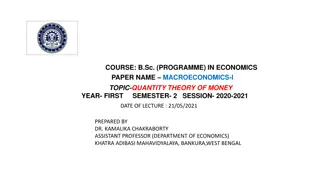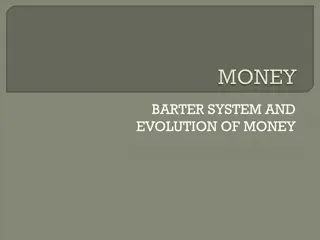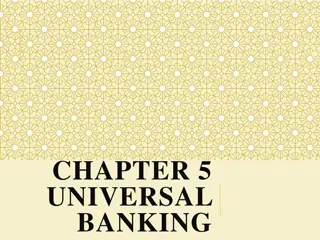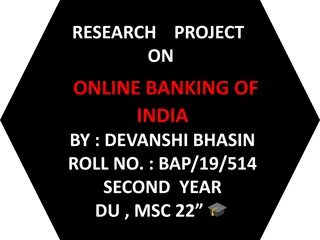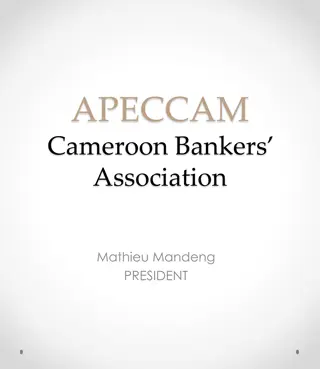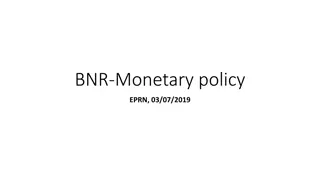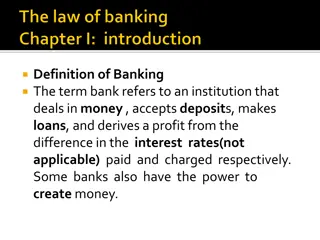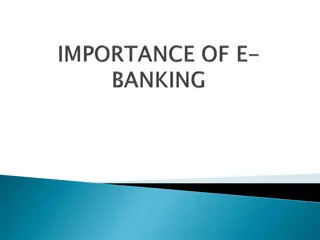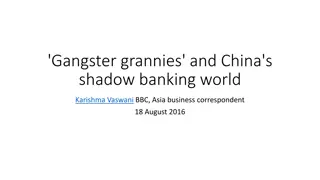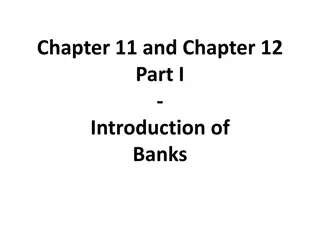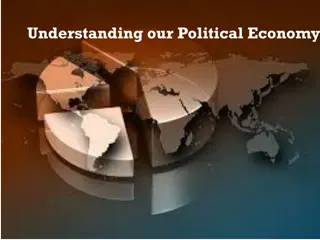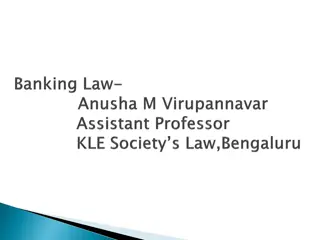Understanding Economics of Money and Banking
This course delves into monetary theories, the financial system, bank management, and regulation. The aim is to provide a comprehensive understanding of monetary policy, financial systems, and their impact on the economy. Through interactive lectures and discussions, students will grasp the fundamentals of money, inflation, and monetary policies. Required readings include "Principles of Money, Banking, and Financial Markets." Evaluation is based on homework, attendance, and exams.
Uploaded on Oct 07, 2024 | 0 Views
Download Presentation

Please find below an Image/Link to download the presentation.
The content on the website is provided AS IS for your information and personal use only. It may not be sold, licensed, or shared on other websites without obtaining consent from the author. Download presentation by click this link. If you encounter any issues during the download, it is possible that the publisher has removed the file from their server.
E N D
Presentation Transcript
1 Economics of Money and Banking
Description of course and Motivation: 2 This course offers a systemic of monetary theories and the financial system. The course will cover the structure and importance of the functions of money, the financial system, bank management and regulation, debates on macroeconomic and monetary policies, the targets and instruments of transmission mechanism of monetary policy and its effectiveness ,money and inflation. monetary policies, the
Course Objective: 3 Our aim in this course will be double. First, to develop a basic understanding of the financial system: how it operates and why it plays a central role in the economy. second, is to analyze in details the aims, conduct, influence, and the limitations of monetary policy. by the end of the course, you should have a firm grasp of the fundamental issues in monetary policy and should more fully appreciate the importance of a well-functioning financial system.
4 Required Textbook: Ritter ,Silber & Udell ,Principle of Money , Banking and Financial Markets 11thedition, available at University Book Store. Supplementary Readings: Business magazine, text books, articles, internet, newspapers.
Course contains 5 Chapter 1: Introduction: Money and Banking and Financial Markets Chapter 2:The role of money in the macro economy: Introducing money Chapter 3:Financial instruments, Institutions Markets and Chapter 4:The monetary theories Chapter 5:The monetary policies Chapter 6:The Inflation
Delivery methods: 6 This course is delivered in the form of interactive lectures summarized in handouts and accompanied presentations. Most important issues within each concept and/or topic are clarified through discussions and class participation. Method of teaching will totally depend on: L=Lecture; D=Discussion by transparency T=Transparency;
Student evaluation as per course outline: 7 Homework ,Attendance and Participation 1stExam 2ndExam Final Exam Total 100% 10% 25% 25% 40%
Chapter 1: Introduction 8 MONEY AND BANKING AND FINANCIAL MARKETS
Why Study Money, Banking, and Financial Markets: 9 To examine how financial markets work To institutions such as banks and insurance companies work examine how financial To examine the role of money in the economy
Introduction of Concepts 10 Financial Markets/Institutions Bringing together of buyers and sellers of financial securities to establish prices The formal setting/mechanism buyers and sellers together to value financial assets Provides a mechanism for those with excess funds (savers) to lend to those who need funds [borrowers] that brings
Introduction of Concepts (Cont.) 11 Money Lubricant that greases the wheels of economic activity Not just limited to currency (bills and coins) also includes demand deposits (checking accounts) issued by banks Plays a key role in influencing the behavior of the economy as a whole and the performance of financial institutions and markets
Introduction of Concepts (Cont.) 12 Money (Cont.) More broadly the monetary economy Facilitates transactions within the economy Principal mechanism through which central banks attempt to influence aggregate economic activity Economic Growth Employment Inflation
Introduction of Concepts (Cont.) 13 Banking Banks and other financial intermediaries (insurance companies, pension funds) take funds from one group (savers) and re-deploy these funds by investing or lending (borrowers) Banks provide a place where individuals and businesses can invest their funds to earn interest with a minimum of risk Well-equipped to invest in the most challenging types of financial investments loans to individuals and small businesses
Introduction of Concepts (Cont.) 15 Banking (Cont.) Banks serve as the principal caretaker of the economy s money supply, and along intermediaries, provide important source of funds Banks are intimately involved in how the central bank of the United States (Federal Reserve) [Fed] influences overall economic activity The Monetary policy is the control of the money supply while using the instruments. The [Fed] directly influences the lending and deposit creation activities of banks. with other financial interest rate and others
16 Economics of Money and Banking
Description of course and Motivation: 17 This course offers a systemic of monetary theories and the financial system. The course will cover the structure and importance of the functions of money, the financial system, bank management and regulation, debates on macroeconomic and monetary policies, the targets and instruments of transmission mechanism of monetary policy and its effectiveness ,money and inflation. monetary policies, the
Course Objective: 18 Our aim in this course will be double. First, to develop a basic understanding of the financial system: how it operates and why it plays a central role in the economy. second, is to analyze in details the aims, conduct, influence, and the limitations of monetary policy. by the end of the course, you should have a firm grasp of the fundamental issues in monetary policy and should more fully appreciate the importance of a well-functioning financial system.
19 Required Textbook: Ritter ,Silber & Udell ,Principle of Money , Banking and Financial Markets 11thedition, available at University Book Store. Supplementary Readings: Business magazine, text books, articles, internet, newspapers.
Course contains 20 Chapter 1: Introduction: Money and Banking and Financial Markets Chapter 2:The role of money in the macro economy: Introducing money Chapter 3:Financial instruments, Institutions Markets and Chapter 4:The monetary theories Chapter 5:The monetary policies Chapter 6:The Inflation
Delivery methods: 21 This course is delivered in the form of interactive lectures summarized in handouts and accompanied presentations. Most important issues within each concept and/or topic are clarified through discussions and class participation. Method of teaching will totally depend on: L=Lecture; D=Discussion by transparency T=Transparency;
Student evaluation as per course outline: 22 Homework ,Attendance and Participation 1stExam 2ndExam Final Exam Total 100% 10% 25% 25% 40%
Chapter 1: Introduction 23 MONEY AND BANKING AND FINANCIAL MARKETS
Why Study Money, Banking, and Financial Markets: 24 To examine how financial markets work To institutions such as banks and insurance companies work examine how financial To examine the role of money in the economy
Introduction of Concepts 25 Financial Markets/Institutions Bringing together of buyers and sellers of financial securities to establish prices The formal setting/mechanism buyers and sellers together to value financial assets Provides a mechanism for those with excess funds (savers) to lend to those who need funds [borrowers] that brings
Introduction of Concepts (Cont.) 26 Money Lubricant that greases the wheels of economic activity Not just limited to currency (bills and coins) also includes demand deposits (checking accounts) issued by banks Plays a key role in influencing the behavior of the economy as a whole and the performance of financial institutions and markets
Introduction of Concepts (Cont.) 27 Money (Cont.) More broadly the monetary economy Facilitates transactions within the economy Principal mechanism through which central banks attempt to influence aggregate economic activity Economic Growth Employment Inflation
Introduction of Concepts (Cont.) 28 Banking Banks and other financial intermediaries (insurance companies, pension funds) take funds from one group (savers) and re-deploy these funds by investing or lending (borrowers) Banks provide a place where individuals and businesses can invest their funds to earn interest with a minimum of risk Well-equipped to invest in the most challenging types of financial investments loans to individuals and small businesses
Introduction of Concepts (Cont.) 30 Banking (Cont.) Banks serve as the principal caretaker of the economy s money supply, and along intermediaries, provide important source of funds Banks are intimately involved in how the central bank of the United States (Federal Reserve) [Fed] influences overall economic activity The Monetary policy is the control of the money supply while using the instruments. The [Fed] directly influences the lending and deposit creation activities of banks. with other financial interest rate and others







